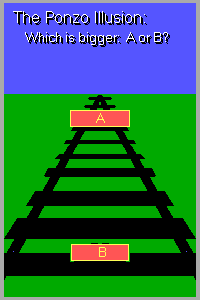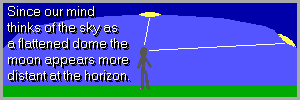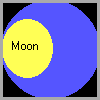Experiment in Perception:
The Ponzo Illusion and the Moon.
 Ever
notice that the moon seems to appear bigger when it is just
above the horizon? Often the explanation given for this is simply
"the moon looks bigger because it is near the horizon." This
seems unsatisfying. What's the scientific reason?
Ever
notice that the moon seems to appear bigger when it is just
above the horizon? Often the explanation given for this is simply
"the moon looks bigger because it is near the horizon." This
seems unsatisfying. What's the scientific reason?
Well, the reason is an optical illusion called
the Ponzo Illusion. The illusion is named after Mario Ponzo
who first demonstrated it in 1913. The Ponzo Illusion shows
that sometimes our mind determines the size of an object based
on the background behind it. Try this experiment:
STEP 1: Look at the diagram to the left.
Which is bigger, Box A or Box B?
Alternate Explanation:
Certainly the moon looking bigger at the horizon is an
optical illusion,but is it the Ponzo effect that's really
responsible? Dr. Don McCready of the University
of Wisconsin has proposed an alternate explanation:
The explanation is based on a pair of illusions known
as oculomotor macropsia and oculomotor micropsia.
Oculomotor macropsia causes objects to appear to
have a larger angular size when we perceive them to be
far away based on distance cues. Oculomotor micropsia
makes objects seem to have a smaller angular size when
they are close to us based on distance clues.
The moon overhead gives us few cues to its distance,
so our eyes assume the object is a distance of one or
two meters (even though we intellectually know it is very
far away) and oculomotor micropsia sets in making
it look smaller than we would normally perceive it. When
the moon is at the horizon, objects on the horizon such
as buildings and trees give us distance clues that the
moon is very far away. This causes oculomotor macropsia
and we perceive it as being larger than it would normally
appear.
Why do oculomotor micropsia and macropsia exist?
Apparently to make it easier and faster for us to turn
our heads and find an object close to our faces. Because
our eyes are on the front of our heads and our heads pivot
near the back of our skull, there can be quite a difference
between the visual angle we see an object to the left
or right and the actual angle we need to turn our necks
to put it square in front of our eyes. The closer the
object, the bigger the difference. Micropsia helps
us instinctively make the right amount of turn when it
is important to find an object quickly because it is close
and might be a threat to us. Because micropsia exists
for close objects, macropsia, the opposite, occurs
for far objects. The misperception of macropsia, seeing
objects too large, is acceptable for far objects
because they do not present an immediate threat to us
and we can take our time turning our necks to find them.
|
STEP 2: Now get a sheet of paper and a
pencil. Put the paper up against the computer screen and mark
the length of Box A on the paper.
STEP 3: Move the paper to Box B. Do the
marks you drew indicate that Box A is larger than Box B?
Most people observe that box A seems larger than
B, but a quick measurement shows they are the same size. Box
A appears larger than B because the background, railroad tracks
disappearing into the distance, gives us the illusion that box
A and B are sitting on the tracks at different distances from
our eyes. Our mind knows that if object A is far away
but is the same size as a nearby object B, object A must
be larger than B. Indeed that would be true if we were looking
at objects on a real set of railroad tracks.
How does this explain the moon illusion? Well,
in our minds we see the sky as a flattened dome. It appears
closer over our heads than near the horizon. This image is reinforced
by objects such as clouds, birds and airplanes which move across
the sky at a uniform height and are indeed closer when they
are overhead and farther away when at the horizon.
 The
moon, of course, is beyond the sky and so far away that, unlike
clouds, planes and birds, it does not really change size based
on being overhead or near the horizon. Still, our minds tend
to think of the moon as a flattened disc stuck on the dome of
the sky. That's how the Ponzo effect comes into play. Our mind
will reach the conclusion that because the moon is near the
horizon it must be far away, but since its size doesn't seem
to decrease, it must be much larger than it is when it is overhead
(when we think of it as being closer), and we see it that way.
The
moon, of course, is beyond the sky and so far away that, unlike
clouds, planes and birds, it does not really change size based
on being overhead or near the horizon. Still, our minds tend
to think of the moon as a flattened disc stuck on the dome of
the sky. That's how the Ponzo effect comes into play. Our mind
will reach the conclusion that because the moon is near the
horizon it must be far away, but since its size doesn't seem
to decrease, it must be much larger than it is when it is overhead
(when we think of it as being closer), and we see it that way.
Here's an experiment to show that the moon is
not actually any larger at the horizon than when it is overhead:
STEP 1: Get a sheet of heavy paper and
cut it twelve to fifteen inches long and five inches or so wide.
You will also need some cellophane tape.
 STEP
2: Pick a night when the moon is full and near the horizon,
and go outside to view it. Roll the paper into a long narrow
tube. Look through the tube at the moon and adjust the tube's
size until the moon appears to fill half the width of the tube
(left). Then tape the tube so the size does not change.
STEP
2: Pick a night when the moon is full and near the horizon,
and go outside to view it. Roll the paper into a long narrow
tube. Look through the tube at the moon and adjust the tube's
size until the moon appears to fill half the width of the tube
(left). Then tape the tube so the size does not change.
STEP 3: Take the tube out again when the
moon is full and overhead. Look at it through the tube. Does
the moon take up any more of the tube than it did at the horizon?
You should observe that the moon does not take
up any more of the tube at the horizon than overhead. This shows
the apparent increase in size of the moon at the horizon is
an optical illusion.

Copyright Lee Krystek
1998. All Rights Reserved.